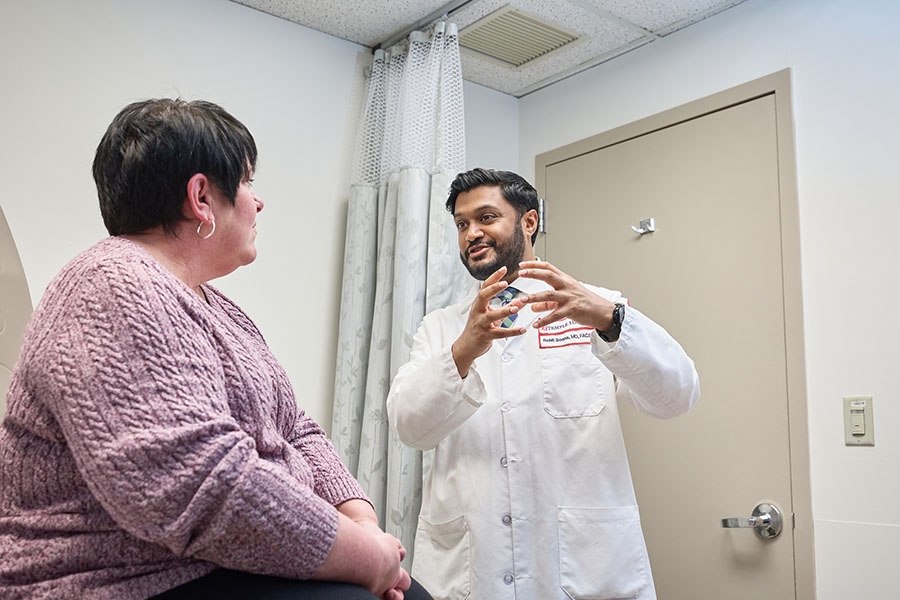As a physician who specializes in physical medicine and rehabilitation, I help many people whose lives and activities are disrupted by back pain. As I explain to them, back pain can be caused by problems with different structures of the spine, including muscles, nerves, bones, and discs. Some of the more common disc problems are degenerated, bulging or herniated discs. It’s easy to confuse these related terms, but they have distinct differences.
I’ll describe what I typically share with my patients about these disc problems. But first, it helps to know a little more about the discs in your spine.
What are spinal discs?
In between the 24 bones (vertebrae) in your spine are rubbery cushions called discs which act as shock absorbers to cushion the spine and help hold it together. Each disc has a tough rubbery shell and a soft, jelly-like center.
What are degenerated discs?
Over time, discs can become drier and less springy. We call this process degenerated disc disease. This process often happens as the result of natural, age-related wear and tear (degeneration) of the spine.
Bulging Vs. Herniated Discs
Sudden injuries, such as a fall, can also damage discs. These injuries can set the stage for the following disc diseases:
- A bulging disc is when the outer shell disc starts to bulge out — much like a bulge in the sidewall of a car tire that has lost some of its air pressure. As people get older, their discs can become drier inside, and this may weaken the outer wall of the disc and cause a bulge to appear.
- A herniated disc is also called a “slipped” or “prolapsed” disc. A herniated disc happens when a weak spot in the wall of a degenerated disc actually tears, allowing the jelly-like nucleus pulposus to leak out and irritate or press on nearby nerves. Because the disc is torn and not simply bulging outward, a herniated disc can be more painful than a bulging disc.
What problems can a damaged disc cause?
The symptoms a person may experience depend, in part, on the location of the degenerated, bulging, or herniated disc.
If the damaged disc is in the lower back, you can have back pain as well as pain that travels down one or both of your lower limbs, which may also feel numb, tingly, or weak.
A damaged disc in your neck can cause neck pain and pain that travels down one or both of your upper limbs, which may also feel numb, tingly, or weak.
If a bulging or herniated disc presses on your spinal cord, it can cause more severe symptoms, such as leg weakness, balance problems, numbness in your genital and anal areas, or even loss of bladder or bowel control. If you have any of these serious symptoms, you should seek medical attention right away.
How are disc problems diagnosed and treated?
Back pain often gets better on its own with appropriate recommendations for self-care — such as activity modifications — including avoiding movements that aggravate the pain. The healing can take days to weeks, but many of my patients have been living with back or neck pain for a lot longer.
We use a team approach for helping people with back pain here at the Temple Universal Back Pain Program. Depending on a patient’s needs, the team may include orthopedic surgeons, neurosurgeons, interventional radiologists, anesthesia pain management specialists, physical therapists and physiatrists (physicians specializing in Physical Medicine and Rehabilitation).
Our work starts with assessing the source of the patient’s back pain. We ask them to describe their pain, a timeline of their pain experience, and its impact on their daily life. We then conduct a physical exam to help us find the source of the pain. The examination sometimes helps us determine if the pain is related to a sore muscle or a nerve problem.
Imaging Tests
We may also order imaging tests as part of the diagnostic process. These include:
- X-rays: This test is used to look for bony abnormalities
- CT scan: This test uses x-rays and computer software to create pictures of the spine.
- MRI scan: This test uses radio waves and magnets to take pictures of the spine to look for soft tissue abnormalities.
- Discogram: A contrast dye is injected into a disc so the fluid’s pressure can recreate the symptoms the person is experiencing. The dye helps show the damaged disc on an imaging scan.
We usually try nonsurgical options to relieve back pain first. For instance:
Physical therapy
During a physical therapy session, can learn various exercises that can help strengthen your core muscles that support your back, and stretching exercises for your muscles, thereby relieving pain.
Injections
Steroid medications injected around the irritated nerve near a disc can reduce inflammation, which helps relieve pain.
Evaluation by a surgeon may be needed if conservative therapies are not enough to relieve pain or if some of the more severe symptoms I previously mentioned (such as weakness, numbness or bladder or bowel incontinence) are present.
Surgery
There are different types of surgery to treat disc diseases. At Temple, we offer advanced minimally invasive and traditional surgical techniques.
For example, options for surgery include:
- Microdiscectomy: This surgery removes the protruding part of the disc.
- Disc replacement: This surgery replaces the damaged disc with an artificial one.
- Spinal fusion: This surgery fuses together two or more vertebrae. This relieves pain by preventing the damaged vertebrae from rubbing together.
Get relief from your back pain
Our team of experts is here to help people find relief from back pain. Our care is aimed at restoring their independence and quality of life by helping them return to a more active and enjoyable lifestyle.
If you are experiencing signs or symptoms of a back problem, schedule an appointment with a member of Temple’s spine team or call 800-TEMPLE-MED (800-836-7536) today.
Helpful Resources
Looking for more information?


